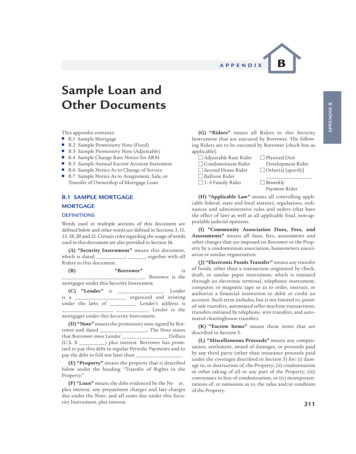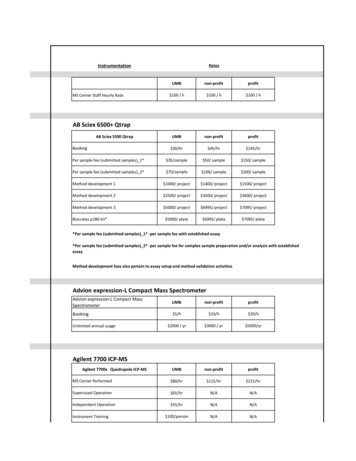
Transcription
CASE STUDYBackground: Sample Preparation forNext Generation DNA SequencingBy Kevin Bodner and Chris Lynch, R&D Engineering, ThermoFisherINDUSTRYMedical TechnologyFigure 1: The SOLiD EZ Bead Emulsifier and a FinishedEmulsion of Aqueous Droplets in OilBackground: Sample Preparation for Next GenerationDNA SequencingThere are two basic steps in DNA sequencing: (1) preparing the DNA sample for sequencing, and (2) using asequencer to detect the DNA sequence of the sample.Typically, sample preparation is a very manual and timeconsuming process. The Life Technologies SOLiD EZBead System for SOLiD DNA sequencing consists ofthree bench-top instruments: an Emulsifier, an Amplifier,and an Enricher, which automate the otherwise laborioustask of preparing a sample for DNA sequencing.The SOLiD EZ Bead Sample Preparation SystemThe goal of sample preparation using the SOLiD EZ BeadSystem for SOLiD sequencing is to prepare the DNA-templated beads that will be deposited onto the glass slide.There are three main steps to doing this, and each isperformed by one of the three instruments in the SOLiD EZBead System.Step One – Emulsification: The Emulsifier instrument(Figure 1) consists of a mixer and a peristaltic pump. Anemulsion is an oil-aqueous-bead mixture and containsuniformly-sized aqueous droplets, with each droplet con-OBJECTIVEOur challenge was to produce a complete software solution to operate a trio of products thatprepares samples for next-generation DNAsequencing. The solution needed to includecommercial shipping software along with software tools for R&D feasibility, manufacturingand field service. We had to deliver robust software within a compressed schedule of ninemonths – without an established softwaredevelopment infrastructure.APPROACHLeverage the commercial software development tools and expertise from JKI’s NICertified LabVIEW Architects to create aflexible, extensible suite of software productsin LabVIEW. LabVIEW and JKI’s Rapid Application Framework for LabVIEW enabled theseamless development of a fully configurablesoftware solution that satisfied ever evolvinghardware and user interface needs.THE SYSTEMNI LabVIEW 2009 SP1JKI VI Package Manager EnterpriseJKI Rapid Application Framework for LabVIEWNI PCMCIA-232/4 Serial InterfaceNI USB-6008 and NI USB-6009Multifunction DAQNI USB-6501 DIONI USB-9162 Module Carrier NI 9211 and NI9213 Thermocouple Input ModulesNI 9215 AI ModuleNI 9472 DO Module
taining one bead. The Emulsifier creates the emulsion by metering the rate of aqueous addition andagitating the oil-aqueous-bead mix for a specified time.Figure 2: The SOLiD EZ Bead Amplifier and Post-PCREmulsion of Amplified DNA TemplatesStep Two – Amplification: The Amplifier instrument (Figure 2) consists of two Peltier-based, verticallyoriented thermal blocks that are sandwiched around a bag of emulsion. Polymerase chain reaction(PCR) chemistry creates many copies of DNA fragments, increasing exponentially, by repeated heatingand cooling cycles. The Amplifier performs PCR on the emulsion by ensuring temperatures are rampedrapidly and accurately. The number of cycles used for PCR, along with the temperatures and hold timesfor each cycle, are easily edited. LabVIEW, running on a netbook computer, controls the Amplifier.Step Three – Enrichment: The Enricher instrument (Figure 3) consists of a syringe pump, 12-wayvalves, solenoid valves, vibrator motors, thermomixer, conductivity sensor, door locks and switches, andLED indicators. Enrichment is the extraction of the desirable beads, those that underwent successfulamplification, from the non-desirable beads, those that did not amplify. The Enricher separates the amplified emulsion into aqueous and oil phases. The aqueous phase is sent through a filter that capturesthe successfully amplified beads. Following several washes, the enriched beads are removed from thefilter and delivered to a collection vessel. LabVIEW runs on a laptop computer to control the Enricher.LabVIEW has played an important role during the last ten years at Life Technologies, used to developsoftware during early instrument prototyping and then for manufacturing test and service. The SOLiDEZ Bead software was the first of its kind, as LabVIEW was used to develop the application used byexternal customers. The use of LabVIEW and VIPM for both the prototype and customer software enabled code reuse while eliminating the need to rewrite software in another programming language. Thiscode reuse allowed us to shorten our development cycles and meet our aggressive scheduleThere were many hardware configurations during the development of the instrument that needed to besupported by the software. Initial breadboards and prototypes made use of off-the-shelf hardware fromCASE STUDY2
NI. Direct serial communication to several components was done through a NI PCMCIA-232/4. Digitalinputs and outputs were provided by NI USB-6008 Multifunction IO devices. Temperature monitoringwas done using NI 9211 and NI 9213 Thermocouple Input Modules housed in NI USB-9162 ModuleCarriers. For the shipping instruments, a custom electronics board and embedded firmware were used,with a single USB connection. The numerous hardware permutations presented a constant challengefor the software.Figure 3: The SOLiD EZ Bead Enricher and Enriched Template BeadsDevelopment of Instrument Control Software for SOLiD EZ Bead SystemR&D scientists and engineers demanded that the software worked continuously on a variety of differenthardware configurations, and remained online 24x7 over time as the hardware evolved. We selectedJKI’s Rapid Application Framework for LabVIEW (RAFL) to meet this challenge. It contains a rich setof built-in features to quickly develop professional and robust commercial software. RAFL has built-insupport for parallel processes, scripting, multiple user screens, and asynchronous communication andcontrol.RAFL utilizes LabVIEW object-oriented programming to build extensible classes of subsystems. Hardware classes were defined for generic hardware components, such as a thermal mixer. Then, as thethermal mixer hardware changed, the methods of the generic thermal mixer could be dynamically dispatched to the method for the new thermal mixer (Figure 4).The development of all three modules needed to be completed on a compressed schedule with limitedresources. As a result, we resorted to a pragmatic approach to software development. We employedbest in class software engineering practices and tools as time allowed, based on informal risk assessments.We used several Agile practices, scrums to facilitate communication and short sprints to prioritizefeatures and break the work down into smaller tasks. Unified Modeling Language (UML) sketches were3CASE STUDY
Figure 4: UML Sketch of a Generic RAFL Subsystemand Specific Hardware Implementationsused during design, while JKI engineers created an invaluable automated software unit test and buildtool. Code reuse was enabled by using JKI’s VI Package Manager (VIPM) to create and manage packages of software libraries. The software team tracked defects during development, while a single software test resource created test plans and executed test cases.Research and Development SoftwareR&D software needs to expose all available functions ofthe hardware to the user. The user requires this level ofcontrol to determine the optimal operation of the hardware. RAFL’s built-in system view (Figure 5) providedready-access to low level manual control and configuration screens for each subsystem. This mechanism enabled users to manually control each subsystem individually and to troubleshoot any problems with connections,communications, or configurations.After the optimal operation of subsystems was determined, they were combined to create chemistry protocols.Scripting was key to enabling the efficient development ofCASE STUDYFigure 5: The RAFL System View AllowsAccess to Low Level Screens4
chemistry protocols. RAFL has built-in support for bothPython and Standard Commands for ProgrammableInstruments (SCPI) through Transmission Control Protocol (TCP) connections. Python, an established programming language, was chosen for its simplicity whileenabling conditional statements, looping, and passingof variable parameters. Scientists developed customPython scripts for all protocols. Python scripts sendcommands to a server written in LabVIEW, listeningon a TCP port, which in turn directs commands to theappropriate subsystem.Once the basic scripts were finished, the R&D RecipeEditor Screen (Figure 6) could be used to modify theparameters and run the script. In this case, LabVIEWloaded and edited Python scripts and sent them toPython for execution.Figure 6Figure 7Figure 8“LabVIEW and JKI’s RapidApplication Frameworkfor LabVIEW enabled theseamless development of afully configurable softwaresolution that satisfied everevolving hardware and userinterface needs.Kevin Bodner,R&D Engineering, ThermoFisher“The use of LabVIEW and VIPMCustomer SoftwareA simplified user screen (Figure 7) and workflow wereneeded for the shipping customer software. Also, thelook and feel of the screens needed to be consistent(Figure 8) across all three modules. Again, flexibilitywas a key contributor to success. We knew final hardware and firmware was not going to be ready in timefor release to early access customers, but RAFL helpedus work around this issue. The early access customersused the final customer screen, without the final instrument configuration. This strategy allowed us to collectimportant feedback on both the software and instrument. Instrument configurations are defined in Extensible Markup Language (XML) files and the required XML5for both the prototype andcustomer software enabledcode reuse while eliminatingthe need to rewrite softwarein another programminglanguage. This code reuseallowed us to shorten ourdevelopment cycles and meetour aggressive schedule.Chris Lynch,R&D Engineering, ThermoFisher
file is loaded at startup. As a result, the same customerscreen can be used to control any combination of hardware components.Manufacturing Test and Service SoftwareThe manual control screens for all of the subsystemsenabled manufacturing test and servicing of the instrument. When a need surfaced to test the Enricher fluidicsystem as a whole, a new screen (Figure 9) was developed. As in R&D, custom Python scripts were createdfor manufacturing tests.“LabVIEW and JKI’s RapidApplication Frameworkfor LabVIEW enabled theseamless development of afully configurable softwaresolution that satisfied everevolving hardware and userinterface needs.Kevin BodnerR&D Engineering, ThermoFisherFigure 9: Fluidics Test ScreenBenefits RealizedWith the release of the EZ Bead system, SOLiD customers can realize an 80% reduction in sample preparationtime, with less than 1 hour of hands-on time now required. Over 200 SOLiD EZ Bead Systems have beenshipped. Combined, customers are performing over1000 runs per month. Six months after product launch,no software patches or upgrades have been required.LabVIEW and JKI’s RAFL architecture enabled a smallsoftware team to deliver commercial software withina nine month period. This achievement resulted in areduced software development expenditure that willresult in a shorter payback period and an increasedreturn on investment. Further, the flexibility and scripting capabilities of the software allows continued protocol development, without support from R&D softwareengineers.63687 Mount Diablo Blvd, Suite 208Lafayette, CA cebook.com/JKISoftwaretwitter.com/JKISoftware
NI USB-6008 and NI USB-6009 Multifunction DAQ NI USB-6501 DIO NI USB-9162 Module Carrier NI 9211 and NI 9213 Thermocouple Input Modules NI 9215 AI Module . loaded and edited Python scripts and sent them to Python for execution. Kevin Bodner, R&D Engineering, ThermoFisher The use of LabVIEW and VIPM











